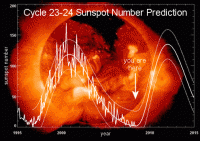By William Briggs, Statistician
The headline comes from this article at NASA. The gist of the article is “that there’s nothing to report.” Says David Hathaway:
“There have been some reports lately that Solar Minimum is lasting longer than it should. That’s not true. The ongoing lull in sunspot number is well within historic norms for the solar cycle.” Although minima are a normal aspect of the solar cycle, some observers are questioning the length of the ongoing minimum, now slogging through its 3rd year. Hathaway has studied international sunspot counts stretching all the way back to 1749 and he offers these statistics: “The average period of a solar cycle is 131 months with a standard deviation of 14 months. Decaying solar cycle 23 (the one we are experiencing now) has so far lasted 142 months well within the first standard deviation and thus not at all abnormal. The last available 13-month smoothed sunspot number was 5.70. This is bigger than 12 of the last 23 solar minimum values.” In summary, “the current minimum is not abnormally low or long.”

See larger image here.
Hathaway’s analysis starts with cycle number “1” (peaking in 1760) and ignores the previous data, which, given the extended period of low to no sunspots from 1650 to 1700, actually weakens his case. This is because, conditional on all the available evidence, periods of time with no or low sunspots are not that unusual. These quiescent periods are more likely given all the evidence than they are just using the data from 1749. This is true based on the simple observation that all the data has more quiescent periods than does the later half. It is true regardless of the periodicities or other structures present. Because we have seen periods in the past with few or no sunspots is excellent evidence, after all, that we will see these periods in the future.
So why would he purposely ignore evidence that would have strengthened his case? Part of the reason is that there is the possibility that the data before 1749 is measured with error, and so should be discounted somewhat. However, this error is not especially large. The real reason has to do with the “Maunder Minimum” (shown on the graph), the period with few or no sunspots. This period does not fit the probability model Hathaway has in mind, so it is ignored. NASA says this about the Maunder: For reasons no one understands, the sunspot cycle revived itself in the early 18th century and has carried on since with the familiar 11-year period. Because solar physicists do not understand what triggered the Maunder Minimum or exactly how it influenced Earth’s climate, they are always on the look-out for signs that it might be happening again.
But Hathaway thinks the “quiet of 2008 is not the second coming of the Maunder Minimum.” Thus we have gone from “For reasons no one understands” to “the solar cycle is progressing normally.” The path from one statement to the other is indeed rocky. This is why I believe Hathaway’s statements are too certain. See Briggs’s post and comments here.
Hathaway has been bullish on cycle 24 for a long time although has speculated on a very quiet cycle 25. See this press release from 2006. By the way we have gone today (7/16/08) 24 days without a sunspot and 73 days since the last cycle 24 spot.

The March 2006 Hathaway forecast and the latest forecast 28 months later. See larger image here.




